A must-read article to everybody who, like myself, is in games development higher education can be found at the excellent Gamasutra website, penned by Michael Prinke. The digital gaming business has grown to a multi-billion dollar industry that refuses to back down even in the face of broad economic problems (not to mention all-too often political criticisms). As such a mesmerizing and popular form of entertainment (and such a lucrative one) it's no wonder that students across the world flock towards it as a career interest.

Digital games, though, are still a very young entertainment medium and still a black box even to veterans who have been making games since the conception of the industry. It should come as no surprise, then, that techniques in teaching to this industry's needs are only in their infancy. What's more in so many peoples' minds games and education are polar opposites. As such, a gap exists between teaching to the professional goals of aspiring students and the academic goals of instructors, to an almost paradoxical degree.
The article tackles this gap by discussing, amongst other things, the common approaches to this educational sector (and also their strengths and weaknesses) such as the skills-oriented approach and the contrasting academically oriented approach. Well worth a read and some reflective thinking afterwards, it can be found here.









